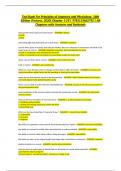Exam (elaborations)
Principles of Anatomy and Physiology, 16th Edition (Tortora, 2020) Chapter 1-29 | 9781119662792 | All Chapters with Answers and Rationals
- Course
- Institution
- Book
Principles of Anatomy and Physiology, 16th Edition (Tortora, 2020) Chapter 1-29 | 9781119662792 | All Chapters with Answers and Rationals
[Show more]



